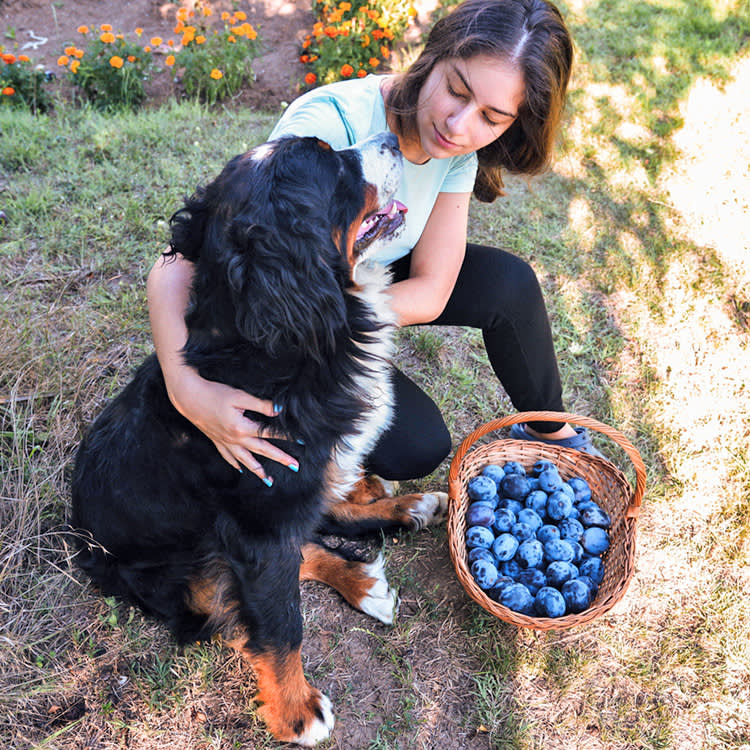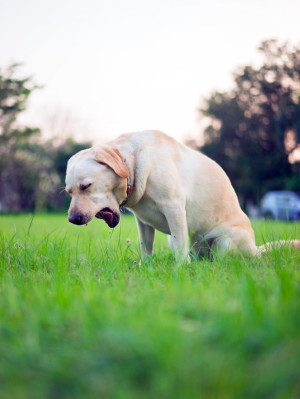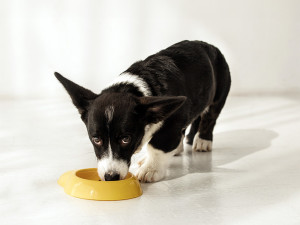Can Dogs Eat Plums?
Sweet and juicy, with a hint of danger? Find out how to safely share this fruity treat with your pup

Share Article
Sharing is caring – or so we’ve always been taught – but what about sharing our fruit with our dogs? Have you ever bitten into the perfect plum, sweet and juicy with a hint of a tartness, and wondered if you can give in to your begging canine companion and let them have a taste?
Plums do have some nutritional health benefits but they also come with dangerous risks so there should be careful consideration before giving your pet a piece of plum to try. Here, we look into the juicy tidbits of information to understand more clearly what we can do to share our sweet treats safely with our pets.

littleKin™ is Kinship’s home just for puppy and kitten parents. Bop over to check out expert advice, new pet tools, and special deals—all curated for your newest family member.
opens in a new tabCan dogs eat plums?
Plums have edible and non edible parts. Yes, dogs can eat the fleshy part of plums. However, care must be taken when feeding the fruit to dogs due to the dangers of the toxic pit in the centre, along with side effects if plums are consumed excessively. The flesh of the plum is highly nutritious, with naturally occurring antioxidantsopens in a new tab and anti-inflammatory propertiesopens in a new tab as well as being high in vitamins C and K which help boost the immune system and the clotting aspects of blood.
However, the pit of the fruit and all other parts of the plant not only are highly toxicopens in a new tab but can also present a choking hazard to your pet. If you do feed part of a plum to your four-legged friend, make sure the fruit is ripe and the pit is removed completely and the flesh of the fruit is cut into small pieces for them. Always monitor your pet when feeding new foods as allergic reactions can occur.
Nutrition facts: plums for dogs
Plums contain many nutritional benefits, let’s have a look at a breakdown of the top components:
Soluble fibre: fibre helps stabilise blood sugar levels and regulates the movement through the gastrointestinal tract.
Vitamin C: an antioxidant that helps the immune system, skin and aids absorption of other nutrients.
Vitamin K: helps with bone health, preventing heart disease and aids in blood clotting in response to injuries.
Potassium: helps control blood pressure and aids nerve function.
Are plums good for dogs?
As we can see there are plenty of nutritional benefits from the flesh of plums for our pets but overall the dangers may outweigh the positives when it comes to feeding plums to our pets. The nutrition is only found in the flesh, the rest of the plant is a whole other story. The pit in particular contains cyanogenic glycosidesopens in a new tab, which means that it can cause cyanide poisoning. Symptoms of cyanide poisoning can be diarrhoea, vomitingopens in a new tab and abdominal pain. Depending on the level of toxicity symptomsopens in a new tab can also include breathing difficulties and heart arrhythmiasopens in a new tab.
Can dogs eat all parts of a plum?
The only part of the plum that dogs (and us humans for that matter) can eat safely is the fleshy outer part of the fruit. All other parts are not safe. In particular the pit, which contains cyanogenic glycosides – a precursor to cyanide – which can be toxic. The plant itself is also toxic to ingest, including the leaves, and especially when wiltingopens in a new tab, so be careful to keep pets away if you grow plum trees in pots or in the garden.
While the flesh of the plum fruit is both delicious and nutritious, there can be too much of a good thing! While plums can help regulate blood sugar levels, eating them in excess can lead to a blood sugar spike, particularly in dogs with diabetesopens in a new tab. There are also negative side effects in relation to the fibre in plums that help give relief from constipation; too much and it can act as a natural laxative and cause diarrhoeaopens in a new tab.
Are plums completely safe for dogs?
No, plums are not completely safe to give to your pet as too much or feeding the wrong part can have risks:
The high sugar content can lead to weight gain, blood sugar spikes and gastrointestinal issues when excessively consumed.
Accidental ingestion of the pit can lead to blockages or choking and potential cyanide poisoning.
Plums contain oxalates which can contribute to kidney stones in susceptible dogs.
Other fruits that are good for dogs
If you want to feed your pet more fruits here are some safer ideas to try:
Blueberries are a great antioxidant-filled snack.
Try bananasopens in a new tab for a low-calorie high-nutrition addition to your dog’s diet.
For a more exotic treat, you can also feed your dog pineappleopens in a new tab.
Fruits that are dangerous for dogs
While there are many safe foods to try there are many foods that are toxic to dogs even when they are safe for us to eat, have a look at these examples:
Grapesopens in a new tab are a big no-go for dogs, as well as raisins.
Avocadosopens in a new tab contain persin, which can be toxic to dogs, so should be avoided at all costs.
Much like plums, the seeds in pearsopens in a new tab, watermelonopens in a new tab and applesopens in a new tab also contain cyanide, which is dangerous in large quantities. Always remove seeds before feeding these fruits to your dog.
The bottom line: can dogs eat human food?
Dogs have evolved alongside us humans and as such they can eat some of the same things we can. However, caution is advised with fruits such as plums due to only part of the fruit being edible. Always check to see if new foods are toxic to petsopens in a new tab even if they are safe for humans. If you are unsure, do not feed them any and consult with your vet. With any new foods there is a possibility of an allergic reaction, so once certain of the safety of the food only try a small taste at first and monitor your pet closely.
Frequently asked questions
Are plum pits toxic to dogs?
Yes, plum pits contain cyanogenic compounds that can be highly toxic to dogs, leading to cyanide poisoning.
Can dogs eat dried plums (prunes)?
No. Once dehydrated, dried plums, or prunes, have a higher concentration of sugars and fibres leading to blood sugar spikes and gastrointestinal issues such as diarrhoea.
What should I do if my dog eats a plum?
If you suspect your pet has consumed part of or a whole plum contact your vet immediately for advice, keep a note of how much and which part of the plant was consumed to tell your vet.
How many plums can a dog eat?
Only feed your dog a small amount of the fleshy part of the plum, if any. Do not feed whole or multiple plums.
Note: while caution was taken to give safe recommendations and accurate instructions in this article, it is impossible to predict an individual dog’s reaction to any food or ingredient. Readers should consult their vets and use personal judgement when applying this information to their own dogs’ diets.
Resources:

Dr Josephine Corrick, BVMSci, BSc, MRCVS
Dr Josephine Corrick, BVMSci, BSc, MRCVS is a veterinary surgeon based in the south of Scotland where she has been since graduating from the University of Surrey. She enjoys working in general practice treating small animals. Her particular interests include diagnostic imaging and the treatment of wildlife.
Having found a passion for veterinary medicine after doing a degree in Equine Sports Science she still enjoys including horses in her life by spending time with her highland ponies. Alongside her clinical work, she helps run a smallholding caring for rare breed sheep and exploring the Scottish countryside with her young Cocker Spaniel.
Related articles
![Girl with plate of kiwi sitting at table stroking dog]() opens in a new tab
opens in a new tabCan My Dog Eat Kiwi?
Your dog can snack on this fibre-fuelled fruit but don't go all out...
![Young couple feeding their dog with healthy green food from the farmers market at home]() opens in a new tab
opens in a new tab8 Seasonal Fruits and Vegetables You Can Share With Your Dog
Eight in-season and vet-recommended fruits and veggies that make for healthy, sustainable snacks for your pet
- opens in a new tab
Can Dogs Eat Peaches?
It’s the best fruit of the season, after all
![black and white Corgi puppy eating out of a yellow dog bowl]() opens in a new tab
opens in a new tabCould Your Dog’s Diet Be Changing Their Behaviour?
It turns out the saying ‘you are what you eat’ isn’t just for humans





